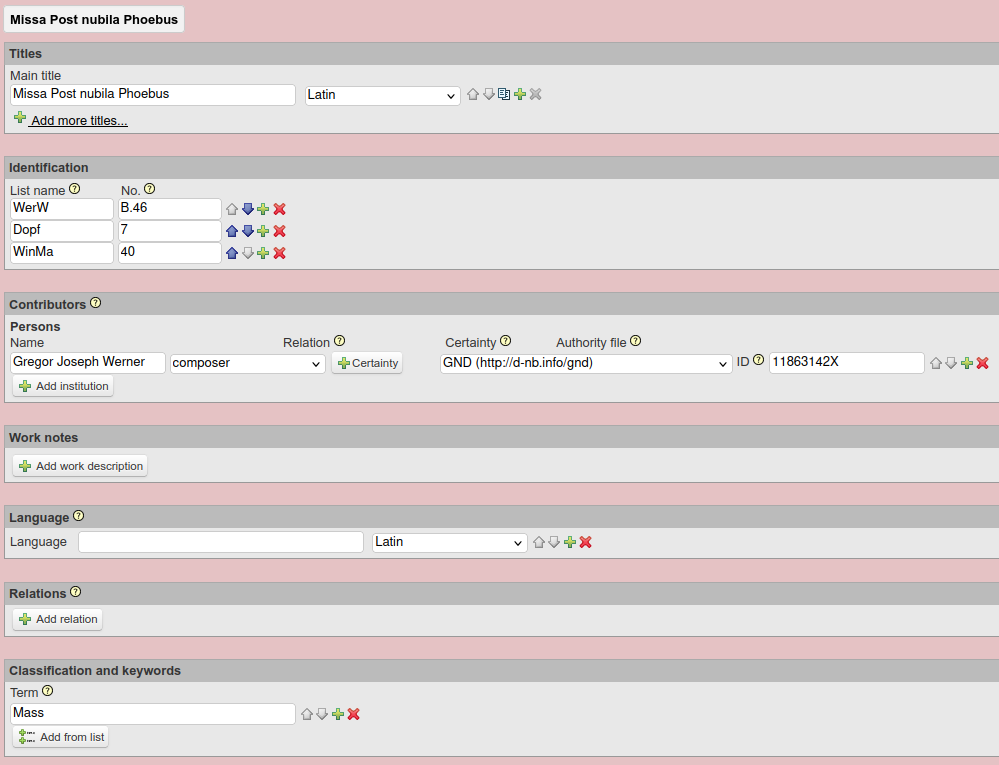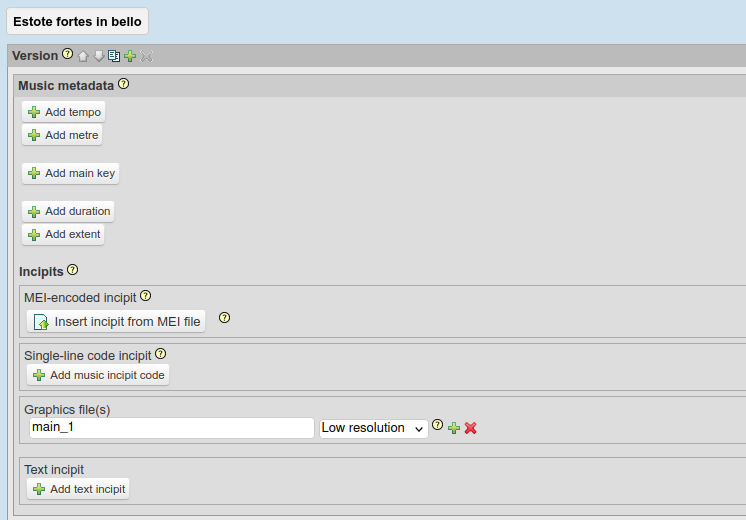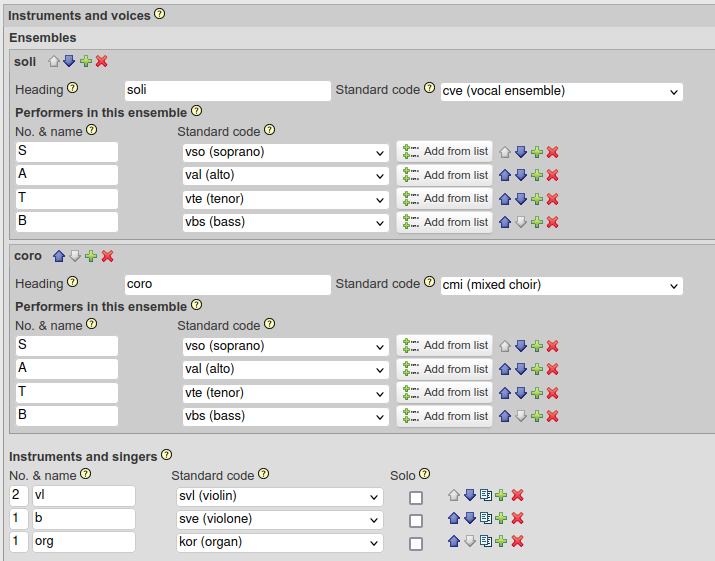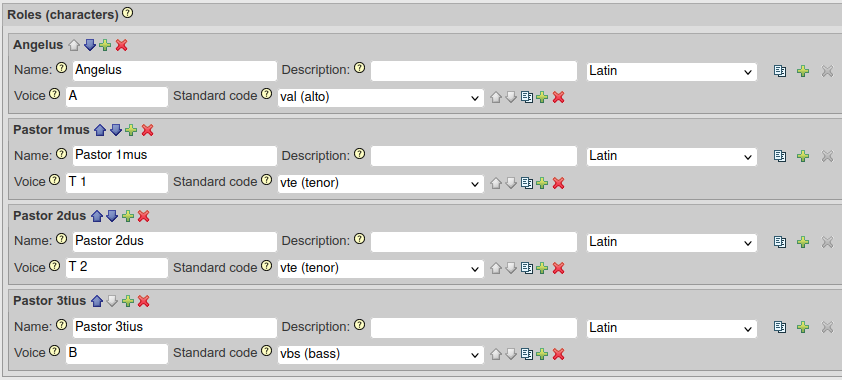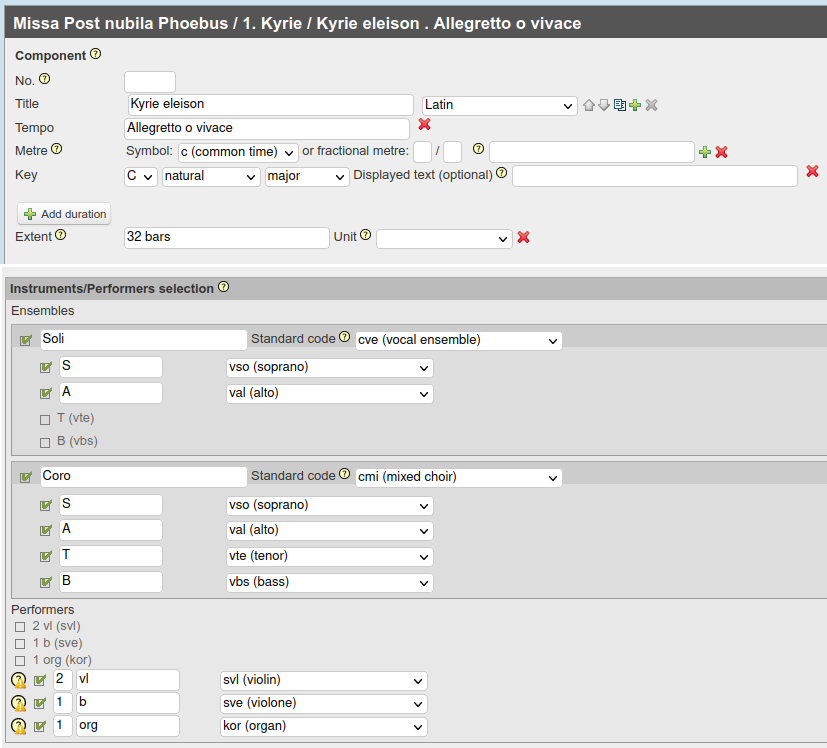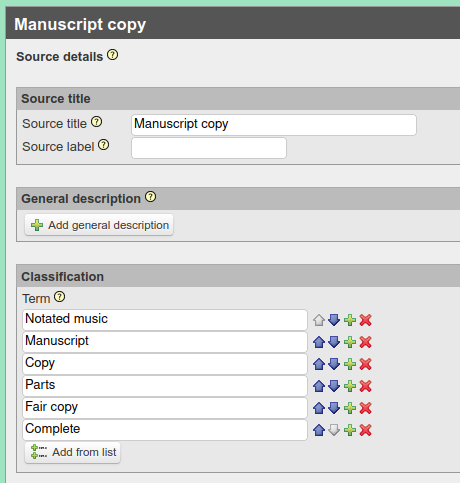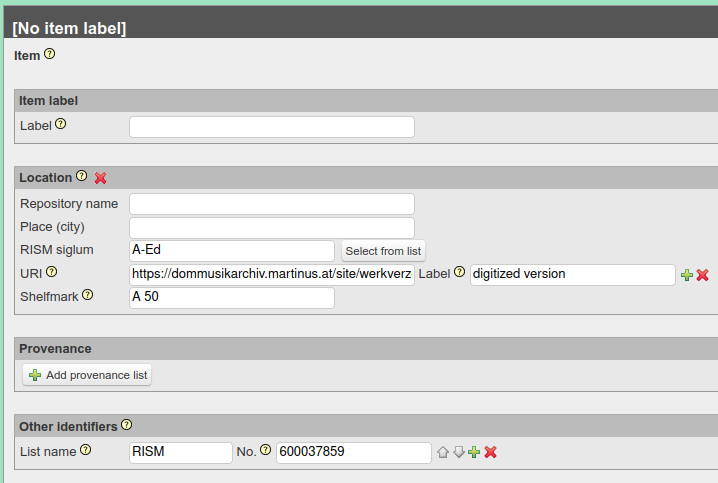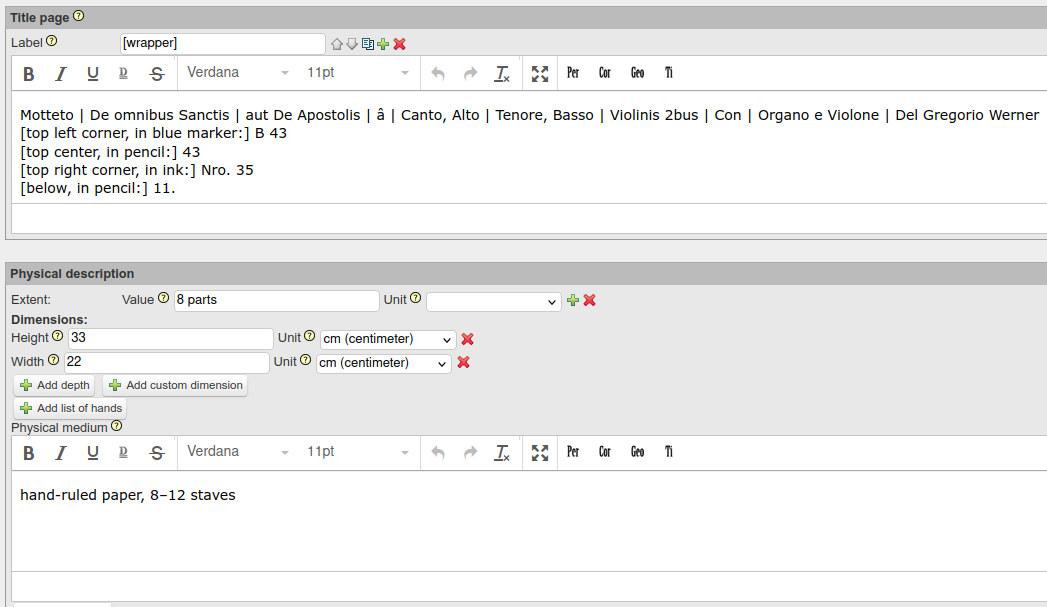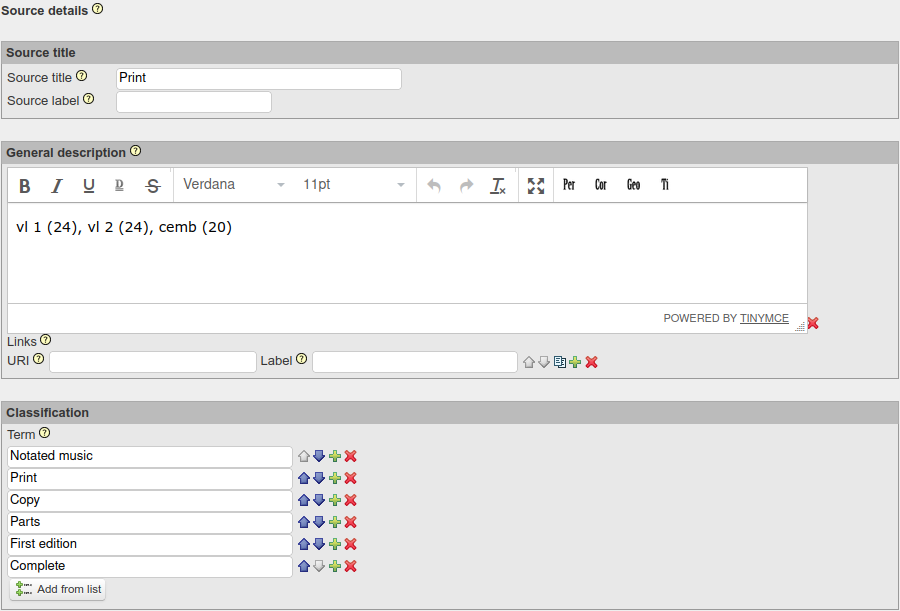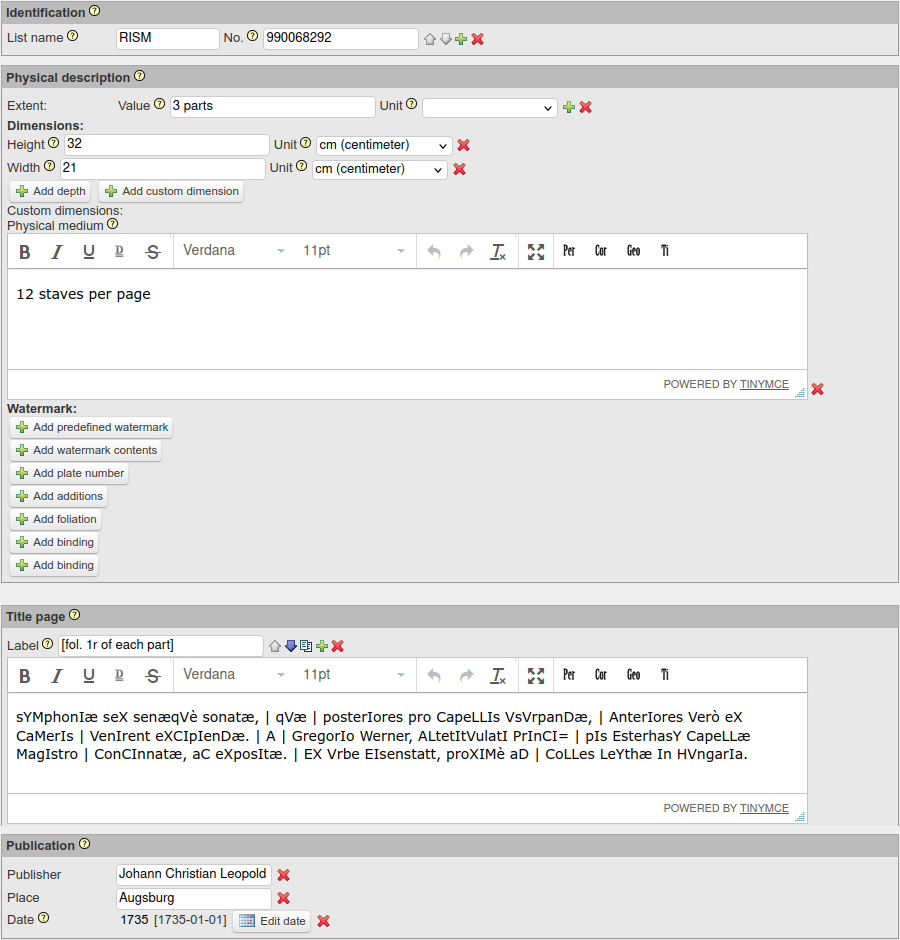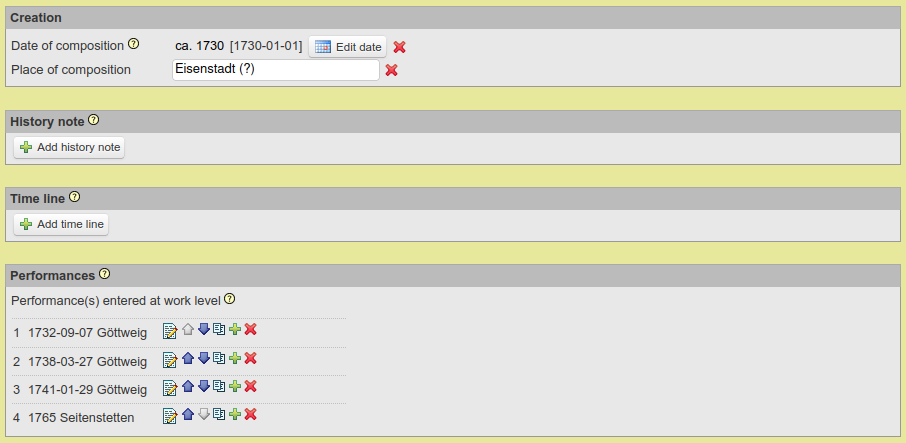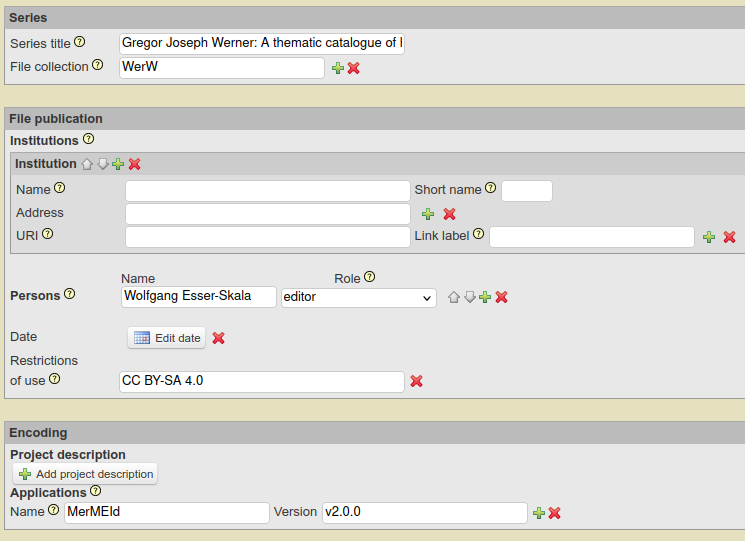Guidelines
The following instructions apply to preparing metadata in MEI format. They are exemplified using mass B.46.
The name of the XML file is WerW_[group]_[number].xml.
Work
- titles: title and language; several titles may be entered
- alternative title: for works with several named movements (responsories like WerW D.3.7, vespers like WerW H.1.8); use a bullet and spaces (“ · ”) as separator
- identification
- WerW: number according to this catalogue
- Dopf: thematic catalogue of masses by Dopf (1956)
- HarBu: thematic catalogues of works in the Esterházy music collection by Hárich (1932), later transcribed by Murányi (1997)
- HarCa: thematic catalogue (unfinished) by Hárich (1990)
- HarIn: Werner’s inventory of 1737/38 (H-Bn Acta mus. 4251; prefixes I–XIII, p. 31–66) and thematic catalogue of 1740 (prefixes A–G, p. 22–31) as described by Hárich (1975)
- PetSi: catalogue of instrumental works by Petermayr (2020) (Kon: Konzerte, p. 462; Par: Partiten, p. 460f; Pas: Pastorellen (geistlich), p. 459f; Sin: Sinfonien, p. 461; Sog: Sonaten (geistlich), p. 458f; Sow: Sonaten (weltlich), p. 460)
- PetWe: catalogue of Christmas music by Petermayr (2015) (P: Pastorellas, p. 190f; V: vocal music, p. 179–181)
- ReiMa: number in the thematic catalogue of masses by Reichert (1935) (p. 141–143)
- WinMa: catalogue of masses by Winkler-Klement (2020)
- contributors: composer with GND ID; use “unknown” for spurious attributions
- work notes: optional general notes on the work, e.g., why is an attribution spurious?
- language
- classification and keywords: genre of the work; use UNIMARC codes for musical forms (field 128)
Music
Music metadata
- add an incipit for each movement (4–5 bars, single staff, graphics file without extension)
Instruments and voices
Use RISM scoring abbreviations and UNIMARC codes for medium of performance (field 126):
- ensembles
- soli (cve)
- coro (cmi)
- coro maschile (cme)
- S (vso)
- A (val)
- T (vte)
- B (vbs)
- instruments and singers
- cnto (bct)
- fl (wfl)
- chalumeau (wch)
- ob (wob)
- cl (wcl)
- fag (wba)
- cor (bho)
- clno (bcl)
- trb (btb)
- timp (pti)
- vl (svl)
- vla (sva)
- vlc (svc)
- b (sve)
- org (kor)
- cemb (khp)
- bc (mco)
Roles
- optionally, add details on roles (name, language, voice, standard code; example: WerW E.34)
Components
General
- indicate missing title by “[no title]”
- several titles can be entered if required (e.g., “Ecce homo” and “Recitativo”)
- indicate missing tempo indication by “[no tempo]”
- incipits: 5–10 bars, all instruments, system layout as in editorial guidelines, omitted bars indicated by dashed double bar line
- duration of da capos: “XX bars (incl. YY bars da capo)”
- indicate solo instruments in the notes (e.g., “clno solo”)
Masses
- movements (e.g., Kyrie):
- number
- title
- tempo
- meter (either symbol, fraction, or free text)
- key (either from dropdown menus or free text)
- total extent (bars)
- instruments selection
- incipit
- movement parts (e.g., Qui tollis):
- title
- tempo
- meter
- key
- extent (bars)
- instruments selection
- notes: indicate da capos by, e.g.
- “da capo of the respective movement in movement”
- “da capo of the first xx bars”
- example: WerW B.46
Short sacred works
- like a single mass movement
- add movement parts if necessary
- example: WerW D.1.1
Long sacred works
- like several mass movements
- add movement parts if necessary
- example: WerW D.3.2
Instrumental works
- movements:
- number
- title
- tempo
- meter
- key
- extent (bars)
- instruments selection
- incipit
Sources
Manuscripts
Enter the following source details:
- source title: one of
- “Autograph manuscript”
- “Partly autograph manuscript”
- “Manuscript copy”
- classification: add six terms from the predefined list
- publication:
- date of writing
- always include it, even if it is only a rough estimate, e.g.
- mid 18th century (machine-readable 1750-01-01)
Then, add a single item:
- location
- RISM siglum
- URI (link to digitized version and/or catalogue entry; several links are supported)
- label (“digitized version” or “catalogue entry”)
- shelfmark
- other identifiers: “RISM” with ID
If a full score or all parts are described, enter the following information on the item level:
- title page with label (like “[fol. 1r, by Kiesewetter]”, “[wrapper]”, “[on binding]” etc)
- use multiple title pages if appropriate
- physical description
- extent (number of parts or number of folios/pages for full scores)
- dimensions (height and width)
- list of hands
- hand is the full name; unknown writers are denoted “unidentified”
- medium is selected from list
- type may be changed (e.g., if a scribe only wrote the title)
- person is deleted
- physical medium
- usually “hand-ruled paper, 8–12 staves” or similar
- if there are several sets of parts, omit dimensions above and write details here (e.g., WerW I.3.3: “two sets of parts: [newline] (1) autograph manuscript, ca. 1760, 8 parts, 16 x 22 cm, hand-ruled paper, 5 staves (10 mm) [newline] (2) manuscript copy, ca. 1790, 8 parts, 15 x 22 cm, hand-ruled paper, 5 staves (10 mm)”)
- general description
- individual parts with number of written pages in parentheses, e.g., “S coro (2), A coro (2), T solo and coro (4), B coro (2), vl 1 (3), vl 2 (3), vlne (2), org (3)”
- include any additional notes as new paragraph
- if only data from the RISM entry and/or literature were used, write “catalogued according to RISM entry and Murányi (1997)” or similar
Lost manuscripts
- source title: “Lost manuscript”
- classification: last term must be “Lost”
- add a single item:
- location (use “Repository name” if no RISM siglum is available)
- (optional) general description
Prints
Enter the following source details:
- source title: “Print”
- classification: add six terms from the predefined list
- publication:
- publisher
- place
- date of printing (mandatory)
Also, add the following information on the source level (see manuscripts for details):
- RISM identifier
- title page(s)
- physical description (extent, dimensions, physical medium)
- general description
Then, add several items where only the location is specified:
- RISM siglum
- URI (link to digitized version or catalogue entry)
- label (“digitized version” or “catalogue entry”)
- shelfmark
In the XML file, manually remove the m: prefix and namespace declaration from the <physMedium> tag.
History
- creation (required)
- date of composition (include at least an estimated date)
- place of composition; use a parenthesized question mark to indicate assumed place, e.g. “Eisenstadt (?)”
- performances (optional)
- date
- venue
- location
Bibliography
- Add a single bibliography with default header “Bibliography”.
- Manually add bibliographic references and modern editions as XML code. Each entry is represented by a
<bibl>element that contains two tags:<genre>: reference, inventory, or edition<ref>: points to a reference using Pandoc Citations format (also see Quarto documentation).<bibl> <genre>reference</genre> <ref targettype="pandoc-citation">@Petermayr2020 [p. 23]</ref> </bibl> <bibl> <genre>reference</genre> <ref targettype="pandoc-citation">@Mikusi2020</ref> </bibl> <bibl> <genre>reference</genre> <ref targettype="pandoc-citation">@WinklerKlement2013 [p. 50]</ref> </bibl> <bibl> <genre>inventory</genre> <ref targettype="pandoc-citation">@EsterhazyInv1805 [fol. 2r, no. 22]</ref> </bibl> <bibl> <genre>edition</genre> <ref targettype="pandoc-citation">@Schmid1940</ref> </bibl>
File
- series and file publication are prefilled from the template
